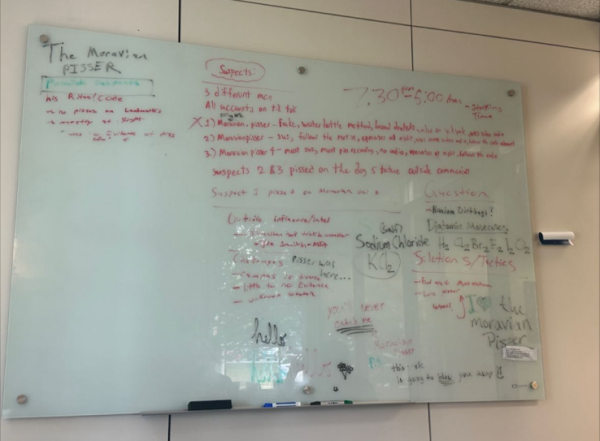Who’s Afraid of Critical Race Theory?
On Mar. 10 in Johnston Hall or by Zoom, students, faculty, staff of Moravian University and members of the community gathered for the second part of the “Who’s Afraid of Critical Race Theory?” panel. At 7:00 p.m. the doors closed and out stepped a speaker.
Fong Tran, poet and activist educator, opened the discussion with a reading of the poem “Dear Young Men of Color”. Through the medium of spoken word rap, Tran addressed the daily struggles of being a non-white male youth. Additionally, the rap brought to the forefront the divisions between marginalized communities created by the ruling hegemony to prevent them from finding their personal power. Notable topics spoken of in the work included statistics of mass incarceration disproportionately strategizing young men of color, stereotyping, and the violence that can and has been enacted as a result of it.
The core of the message of the opening speech, which carried throughout the panel, is the notion of deconstructing the status quo of a racist, class-based system which favors a white, upper class. Calling to attention the conflicts the rich make the poor engage in, generational traumas and the Prison Industrial Complex, Fran ended the speech with the message “you [young men of color] can change the world.”
Following the opening poem, President Bryon Grigsby welcomed to the stage Dean Christopher Hunt of the Office for Diversity, Equity, and Inclusion and Dr. Harrison Bailey III. Bailey has been an activist for years and was named Pennsylvania’s 2021 Secondary Principal of the Year for his 25 years of work at Liberty High School in Bethlehem. Under his guidance, Liberty became one of the most trauma-informed PA high schools and hosts a number of programs like the Multicultural Student Leadership Conference that promotes understanding the diversity in experiences and its student body.
The discussion began with a disclaimer that anything said by either Dr. Bailey or Dean Hunt does not reflect the interests of any group, nor is it a reflection of the curriculum at large, but comes from the perspective of a Black husband and father. The purpose of the panel is to discuss the woven strands of racism within the current academic systems. Secondarily, even if one were to not take much from the content of the panel it has become the hope that questions, most of all, are raised in every regard to Critical Race Theory, racism, institutions, and society as a whole.
When speaking of race in any context, Dr. Bailey and Dean Hunt both remarked, it can trigger a strong emotional response from audience members. It has been interwoven in institutions since the concept of race was created sometime around the 1600s. It is another form of hierarchy that has become deeply entrenched in culture, despite race having no provable scientific foundation.
Institutions and the intersections of race have never been about white people, but the concept of whiteness and who has access to it. Though many overtly racist policies and acts have faded from the spotlight, such as slavery, Jim Crow, racial science, etc., they have left aftershocks that ripple into the modern day. Critical Race Theory is a mechanism to understand those effects.
CRT has been around for 40 years with the single belief that racism is not an individual bias, but an all-encompassing feature of modern Western institutions that has become so embedded in them that it takes a critical lens to see. By not acknowledging these implicit biases, the context of Historically Black Colleges among many other facets of society are without meaning.
The application of Critical Race Theory highlights everything that strips away every person’s humanity towards one another – be it overt or not. CRT, therefore, is not an active threat against white persons as many would believe but a call-out on whiteness which has led to white supremacy. The usage of the theory as a political dog whistle denies the historical truths that the United States and much of Europe was built upon the oppression of non-white groups, in particular the enslavement of Black individuals.
An emphasized point was CRT as a conduit to express historical pains of the racially marginalized and is an avenue for “white guilt.” The theory is not about guilt. Any and all guilt one may feel, any and all discomfort one may experience, it was said, is that common humanity shining through. Uncomfortable feelings and discourse are key to the survival and understanding of the perspective. Ultimately, it is an acknowledgement of the perseverance of those who have suffered, in addition to dismantling the oppressive structures to rebuild them for a more equitable future. Healing and progress can only occur once the wound is recognized.
Final affirmations from Bailey and Hunt further demystified the misconceptions many have about Critical Race Theory.
Among them, one must consider that for those who have had every privilege given to them by birthright, the ideals of liberation, equality, and equity may feel oppressive. However, there is no hostile or vengeful intent with exploring this history. Black History Month, for example, is a time to highlight exceptional Black individuals, acts, creations and movements. Empathy is core to CRT; viewing the world by walking in another person’s shoes and walking another mile to hand them back.
Closing out the panel, a forum was opened with the acknowledgement of the Indigenous Lenape who inhabited the land before Moravian University. The topics discussed with the audience included how having tough conversations is important, especially on college campuses, due to their diversity in opinions and backgrounds. And with the desire for engagement in such difficult conversations, today’s youth is ready to have a multitude of voices and persons being represented.







